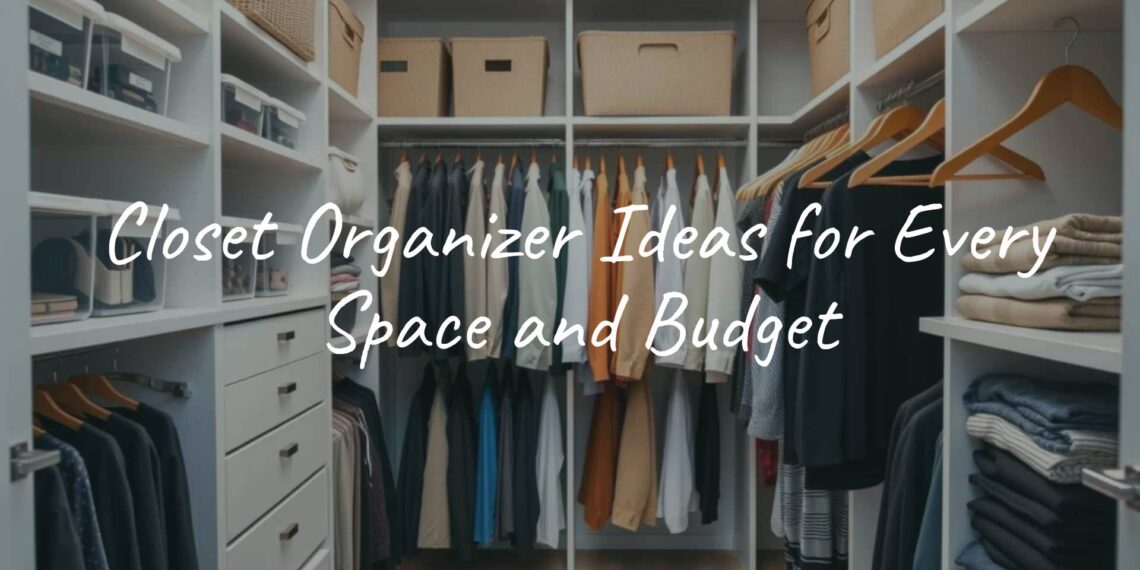Closet organizer ideas are simple plans and tools that turn messy closets into calm, useful, and good-looking spaces. A well-set-up closet can speed up your mornings, lower stress, and help you build a wardrobe you enjoy wearing. It’s about more than tidying. The goal is a setup where every item has a place, you can grab things fast, and your clothes and accessories stay in good shape.
These ideas range from quick DIY fixes to custom-built setups, all aimed at saving space and time. Whether your closet is a small reach-in or a roomy walk-in, smart organizing can make a big difference. Instead of stuffing items anywhere, build a system that supports your daily habits and style, so getting dressed feels easy and even a bit enjoyable.

Why organize your closet?
Organizing your closet brings many benefits beyond a neat look. It can speed up your mornings. Think about finding your socks and favorite shirt right away, as IKEA’s home design team suggests. When everything is ready to go, you save time and avoid morning stress.
It also protects what you own. Poor storage can lead to lost items, damaged bags, and wrinkled clothes. A simple system helps clothes last longer and stay ready to wear. A tidy, nice-looking closet can even feel like a calm spot in your home where getting ready feels peaceful.
Common challenges in closet organization
Closets often end up chaotic. The biggest issue is having too much stuff. Large amounts of clothes, shoes, and accessories can overwhelm any setup. Things get shoved anywhere, and finding what you need becomes hard.
Another hurdle is weak storage design. Many closets come with basic parts that don’t fit your needs. Without the right shelves, rods, or drawers, items pile on the floor or stretch hangers. ADHD organizing specialist Kat Green says many people keep the original closet layout instead of shaping it to fit their life. This wastes space, especially high space, and makes it hard to keep order. Also, staying organized takes upkeep. Without a system you can maintain, clutter returns fast.
Types of closet organizers
Closet organization offers many tools and systems to help you cut clutter. From main structures to small add-ons, knowing the types of organizers is the first step to a setup that works. Each type solves a specific need, and you can mix them to build a complete system that fits your wardrobe and habits.
Whether you want permanent built-ins or flexible, portable pieces, there’s an option for everything from daily wear to seasonal items. Pick pieces that fit your space and match what you store and how often you grab it.
Shelf and rod systems
Shelves and rods form the base of most closets. Shelves hold folded clothes, bags, and bins. Placing shelves at smart heights helps save space and makes access easy. Deeper shelves suit towels or big bins. Shallow ones work well for shoes and small items.
Hanging rods keep wrinkle-prone clothes neat-think dresses, blouses, skirts, and slacks, as Corey Pence from The Container Store advises. Use rods at different heights to fit short and long items. A double-rod setup can almost double capacity: blouses up high and pants or skirts below. Layering like this makes outfits easier to pick and keeps the space tidy.

Hanging organizers and cubbies
Short on floor and shelf space? Hanging organizers and cubbies make great use of height. They hook onto your rod and offer slots for folded clothes, accessories, or shoes. The Container Store’s 6-Compartment Hanging Wide Closet Organizer, made from a breathable poly-cotton blend, is a good example. For a cheaper all-plastic choice, IKEA’s Skubb hangs with Velcro and works well too.
Cubbies, either standalone or part of a bigger system, give each item a clear spot-from shoes and handbags to folded tees. They shine in small closets by using vertical space well. Add bins inside cubbies for hidden storage to keep the look clean while reducing visual clutter.
Drawer dividers and bins
If you have drawers in your closet or a dresser, dividers and bins keep small items under control. Without them, drawers become a jumble of socks, underwear, and accessories. The Container Store’s 4″ Dream Drawer Organizers keep clothes separated and easy to grab. They adjust to fit and can divide drawers either way, which is great for socks and intimates.
For narrow drawers, OXO Good Grips Expandable Drawer Dividers are a sturdy, easy option. While they don’t split the space further, their strong build helps keep order. Soft bins in different sizes work well for watches, gloves, or scarves. Clear, stackable bins like The Container Store Clearline Open Bins are great for shirts and sweaters, letting you see what’s inside so nothing gets lost.

Over-the-door racks and hooks
Use your door space. A swinging door is prime storage you might be missing. Over-the-door racks and hooks add lots of capacity. Hang an organizer on the inside for hidden storage. Use a nicer-looking rack outside if you want quick access and a bit of style.
The Target Brightroom Over The Door 26 Shelf Mesh Shoe Organizer has many mesh pockets for shoes and rolled clothes like tees or leggings, plus belts and small bags. For scarves and ties, the Target Brightroom Over the Door Tiered Towel Rack with Wood works well even though it’s meant for towels. Minimal options like the Yamazaki Home Over-the-Door Hanger give you sleek hooks for hats and totes. These tools free up shelf and rod space inside the closet.
Shoe storage solutions
Shoes can be tough to store, especially since many people own a lot of pairs. The goal is to keep them visible, sorted, and easy to reach. Small cubbies fit sneakers or slim sandals. Wider pullout shelves fit mixed styles.
The Seville Classics 3-Tier Resin Slatted Shoe Rack is a favorite for its sturdy build and use of vertical space, so shoes don’t pile on the floor. You can stack it and even store more than shoes. Tall boots can sit on high shelves off-season or on trays on the floor when in use. Clear acrylic shoeboxes protect shoes while keeping them visible and stack neatly. Over-the-door and hanging organizers also save floor space and use height well.
Accessory organizers
Accessories come in many shapes and sizes, so they need smart storage to avoid tangles. A jewelry tree or box keeps necklaces neat and pairs earrings. If you like a clean look, use drawer organizers for jewelry. Small hook racks, like Franklin Brass Wall Hooks or the Drop Metal Modern J Hook, are great for belts, necklaces, or caps, keeping them in sight.
Purses can hang on hooks or hangers on a blank wall or inside cabinet doors. Small clutches fit neatly into shoe cubbies. Store seasonal items like scarves, gloves, and hats in lidded bins on high shelves and swap them by season. A narrow console under wall hooks can hold sunglasses and small items, so every piece has a clear spot.
Vacuum storage and under-bed options
If closet space is tight or you need long-term storage, vacuum bags and under-bed bins help a lot. Spacesaver Vacuum Storage Bags shrink bulky bedding, pillows, and off-season clothes to save space. Plain bins or blanket bags are usually better for clothes, but vacuum bags can help when space is very limited. Avoid storing foam or down items compressed for more than a year, or they may not bounce back.
Under-bed storage is great for things you use often but don’t need in the closet. The Iris Under Bed Drawer slides easily and works for daily access. These drawers are under 6 inches tall and about 30 inches deep, fitting under most beds or at the bottom of a closet. Use these tools to stash off-season clothes or special items, keeping the main closet free for daily wear.
How to choose the best closet organizer for your space
Picking the right organizers is personal. It depends on your space, your habits, and what you own. The best setup fits into your daily life and makes it simpler, not harder. Start with a clear look at what you have and what you want.
Before you buy or build, take time to map out what you own, where it should go, and how you use it. This planning step guides your choices and helps your budget go further, turning your closet into a space that works and feels good.
Measuring your closet space
Start by carefully measuring your space. Use a tape measure and write down height, width, and depth. These numbers decide what will fit and work well. A narrow closet might need slim organizers, while a deep one could handle pull-out drawers.
Check what’s already there: fixed shelves, a single rod, or built-in drawers. Note angled ceilings, corners, and any obstacles. Use height well, especially in small closets, so measure floor to ceiling. This careful measuring step acts like your plan and helps you pick pieces that fit, not just guess.
Defining your storage needs
Now look closely at what you own. Sort everything that will live in your closet. Start with a clear-out. Let go of items you haven’t worn in a year, with exceptions for favorites and classics, as Sanctuary Home Decor suggests.
Then group what’s left. How much needs hanging vs. folding? Do you own many shoes, or do you need more drawer space for accessories and intimates? Think about types of clothes (formal, casual, workout), what you use most, and how often. If you wear jeans daily, keep them easy to reach. This count helps you pick the right mix and number of organizers that fit your style and needs.
Planning for easy accessibility and visibility
An organized closet works best if you can see and reach everything. Plan for easy access and clear views to cut search time and avoid stress. Think about how you move in the space and what you grab most.
Keep “prime spots” at eye level, as Jamie Hord explains. Daily items go here. Store off-season or rare items up high, under the bed, or in another room. Use clear bins or shallow stacks so folded items don’t get lost in deep piles. Good lighting matters too. Battery lights or motion strips help you see colors and pick items fast. A setup that feels natural to use is the sign of a strong system.
Maximizing closet space with smart organization techniques
Even a big closet can feel tight without a smart plan. To make the most of your space, think vertical, use doors and walls, and build clear zones for different items. Give every item a home so nothing goes to waste.
With a few smart moves, even a small closet can work hard. It is not about adding endless organizers. It’s about using the space you already have in a better way.
Using vertical space effectively
Vertical space is often left unused, but it can add a lot of storage. Build up, not out. Floor-to-ceiling shelving can be a big win, especially in small homes. Adjustable shelves let you set the height for tees, sweaters, or tall boots.
Hanging organizers use height well by adding many compartments to one rod. Double-rod systems boost hanging space by stacking short items one above the other. Use the top shelf for bags and off-season items in labeled bins. Keep a small step stool nearby so the highest spots are still useful.
Using closet doors and walls
Doors and blank walls can hold a lot. If you have a swinging door, make it work for you. Over-the-door organizers hold shoes, rolled clothes, or belts and scarves. The Target Brightroom Over The Door 26 Shelf Mesh Shoe Organizer holds many small items and frees space inside.
Use hooks on open wall space for hats, bags, and scarves. The Drop Metal Modern J Hook and Franklin Brass Wall Hooks both work well. A narrow console below hooks can hold sunglasses and jewelry, with hampers tucked underneath. These small changes can add a lot of extra storage and keep daily items close at hand.

Creating dedicated zones for folded, hung, and bulky items
Give each type of item its own area. Wrinkle-prone items like dresses, blouses, skirts, and slacks go in a hanging zone. Slim, matching hangers, like Amazon Basics Slim Velvet Hangers, save rod space and keep clothes from slipping.
Fold sturdier items like denim, sweaters, tees, and workout gear. Stack them on shelves with dividers such as Lynk Tall Shelf Dividers to keep piles neat. Use drawer dividers for socks and underwear. Put bulky or seasonal items-winter coats, blankets, luggage-up high, under the bed, or in vacuum bags so they’re out of the way until you need them. Clear zones make the whole closet easier to use and keep tidy.
Closet organizer ideas for every closet size
No matter how big or small your closet is, there are smart ways to make it work better. The trick is to know the limits and strengths of each type and apply the right fixes. Small closets need creative use of height and slim pieces. Large walk-ins benefit from clear zones and display areas.
Don’t feel stuck because of size. With the right plan, any closet can be useful and even inspiring, making your day run smoother.
Small closet solutions
Small closets can work well with the right approach. The golden rule is to use every inch of height. Add floor-to-ceiling shelves and double-hanging rods to save floor space. Slim organizers fit tight areas and still hold a lot.
Try multi-use pieces like a storage bench that offers seating and hidden space. Over-the-door organizers hold shoes, accessories, or rolled clothes. Jamie Hord suggests keeping daily items in the “prime spots” and moving off-season pieces up high, under the bed, or into vacuum bags. Small, smart changes can make a big impact.
Ideas for reach-in closets
Reach-in closets are shallow with one opening, so visibility matters. Simple modular systems, like ClosetMaid’s Stackable Vertical Organizers, add shelves, cubbies, and drawers without drilling into walls. You can arrange them to fit from wall to wall.
Sort hanging clothes by type and color. Use slim, matching hangers to tidy the rod. Shelf dividers keep stacks from falling. Use the back of the door for hooks or shallow organizers. If you don’t have drawers, use clear, stackable bins so you can see what’s inside from any angle.
Walk-in closet organization strategies
Walk-in closets give you room to plan more. Custom systems from home stores let you pick drawers, rods, and shelves that fit your wardrobe. Many can be installed over a weekend and make an 8×10-foot closet feel like a dressing room.
For a boutique feel, alternate shoes, hats, and bags on shelves. Wire systems help air flow and often have clip-on dividers. Set clear zones for different types of clothes and accessories. Add a small charging spot, a jewelry tree or drawer inserts, and a mirror or small vanity if you have space. Use out-of-the-way spots for luggage and keep a basket or drawer for fabric care supplies. This makes every item easy to find and put away.
Budget-friendly DIY closet organizer ideas
You can get a tidy closet without hiring a pro or spending a lot. Many good-looking, effective fixes are possible with basic DIY skills. DIY saves money and lets you build a setup that fits your space and needs. With a bit of creativity, everyday items can become useful organizers.
Making your own tools feels great and adds a personal touch. From repurposing to simple builds, these ideas show you can get an organized closet on any budget.
Repurposing everyday items
Repurposing is a fun way to save money. Use old baskets for scarves, belts, or folded tees. Cover sturdy shoeboxes or decorative boxes with fabric or paper for small items, keeping them tidy and dust-free.
Cut and stack PVC pipes to make shoe cubbies. Turn glass jars into holders for jewelry or hair ties in drawers or on shelves. Think creatively about common items and how they might solve your storage problems in a new way.

Simple DIY shelving and cubby projects
If you need more shelves or cubbies, try easy DIY builds. Projects like DIY closet cubbies or simple shoe racks often need only basic tools. Plywood is affordable and versatile, and you can pick a grade that balances cost and strength. For a nicer look, use oak or maple on visible parts.
You’ll find many free plans online, including wood closet shelves or a rotating shoe rack to pack in more shoes. Build to the exact size of your closet so no space is wasted. A quick coat of paint, like chalk paint inside cabinets with quotes, can make a simple project feel special.
Customizing organizers for unique needs
DIY lets you solve needs that store-bought items can’t. If you have many hats, build a hat rack to display them well. Many purses? A custom purse rack will help them keep their shape and stay easy to grab. A hidden door shelf is harder to build but shows how creative storage can be.
If belts are the issue, make a simple hook rack. If moths are a problem, clear, linen-covered drop-front boxes can protect sweaters while keeping them visible. Look at your wardrobe and habits, then design organizers that solve your exact pain points and match your style.
Tips for maintaining an organized closet
Setting up an organized closet is a win, but keeping it that way takes steady habits. Without simple routines, clutter creeps back in. A lasting system should be easy to maintain so your closet stays neat without a lot of effort.
Treat upkeep as part of the process. With a few regular habits, your closet can stay calm and useful year after year.
Decluttering and rotating clothing regularly
Long-term order starts with regular clean-outs. The KonMari method says to keep items that spark joy, but you can keep it simple: let go of what you haven’t worn in a year, keeping sentimental or timeless pieces. This frees up space for what you actually wear. Some people sort while wearing a robe so they can try things on fast.
Rotate by season too. Store off-season clothes in vacuum bags, under-bed drawers, or labeled bins on high shelves. This keeps your current items front and center and prevents a crowded feel. When the season changes, swap items and use the chance to edit again.
Labeling and categorizing items
Even a tidy closet can be confusing without labels and categories. Group hanging clothes by type (blouses, dresses, pants) and then by color. Folded items can be grouped by type (sweaters, tees, athletic wear) and stacked or put in bins.
Use adhesive labels on bins, boxes, and drawers. Label seasonal items and accessories. In a walk-in, you can add a small “prep” section labeled for days of the week to plan outfits. Clear labels help everyone put things back in the right spot.
Preventing clutter buildup over time
Keep clutter from returning with a few habits. Try “one in, one out”: bring in something new, donate or toss something old. This keeps your wardrobe size steady.
Put things away right after use. Don’t let clothes pile on chairs or floors. Do a quick tidy once a week-refold piles, rehang items, and put things back in place. Check organizers now and then, especially DIY builds, to keep them sturdy. Small, steady actions keep your closet looking neat for the long term.
Frequently asked questions about closet organizer ideas
How do you make a small closet feel bigger?
Use height and simple storage to make a small closet feel larger. Install floor-to-ceiling shelves and double rods to use all the vertical space. Slim, matching hangers free up rod room and give a clean look.
Add storage that doesn’t bulk up the space. Use over-the-door organizers for shoes, accessories, or rolled clothes. Clear bins and drawer dividers keep items contained and visible. Good lighting helps a lot, since bright spaces feel larger. Finally, declutter often. Follow Jamie Hord’s tip: move rarely used items up high, under the bed, or to another room. Less stuff makes any closet feel bigger.
Are custom closet systems worth it?
It depends on your needs, budget, and how much you value a smooth setup. Many people find custom systems are a smart spend. They are built for your space and use every inch well with custom shelves, drawers, and hanging areas. This can turn a messy closet into one that’s easy to use and nice to look at.
Custom systems may also add home value since many buyers like good storage. While they cost more up front than basic options, they tend to be durable, fit well, and look polished. If you have tricky storage needs, a large wardrobe, or want a high-end look, a custom setup can save time and stress over the long run.
What is the most efficient way to arrange clothes?
Mix smart hanging, neat folding, and clear categories. Hang items that wrinkle easily-dresses, blouses, skirts, and slacks-just as Corey Pence suggests. Group by type, then by color, and arrange from short to long. Use slim, matching hangers to save space.
Fold sturdier items like denim, sweaters, tees, and athleisure. Try Marie Kondo’s vertical folding to save drawer space and keep items visible. Use dividers in drawers and on shelves to keep piles upright. Create zones for workwear, casual, accessories, and intimates. Keep editing and rotate by season so your daily items stay close at hand and your system keeps working well.
| Organizer type | Best for | Example |
|---|---|---|
| Shelves & Rods | Folded items, hanging clothes | Double-rod setup for blouses/pants |
| Hanging Organizers | Tees, accessories, lightweight shoes | IKEA Skubb, 6-Compartment Organizer |
| Drawer Dividers | Socks, underwear, small items | Dream Drawer Organizers, OXO Dividers |
| Over-the-Door | Shoes, scarves, belts | Brightroom Mesh Shoe Organizer |
| Shoe Racks/Boxes | Visible, tidy shoe storage | Seville 3-Tier Rack, Acrylic shoeboxes |
| Bins & Cubbies | Folded clothes, bags, clutches | Clearline Open Bins, shelf cubbies |
| Vacuum/Under-bed | Off-season and bulky items | Spacesaver bags, Iris Under Bed Drawer |
















![What to with Scrap Metal? [infographic]?](https://facts-homes.com/wp-content/uploads/2019/07/645413-POPYOV-391-120x86.jpg)





